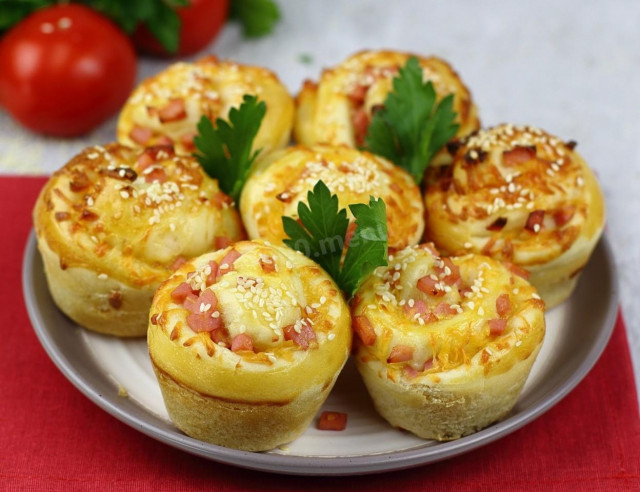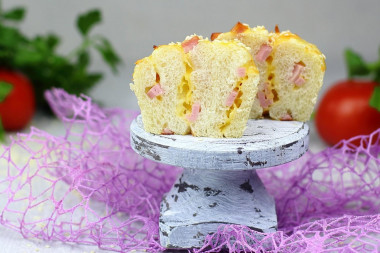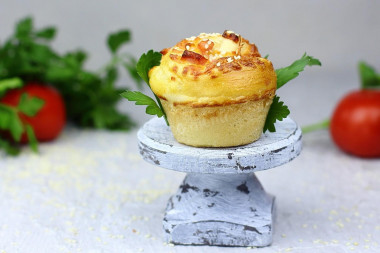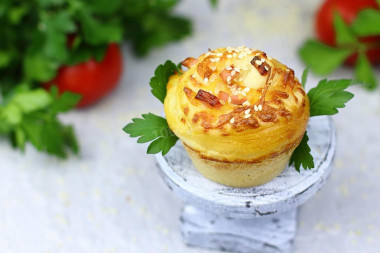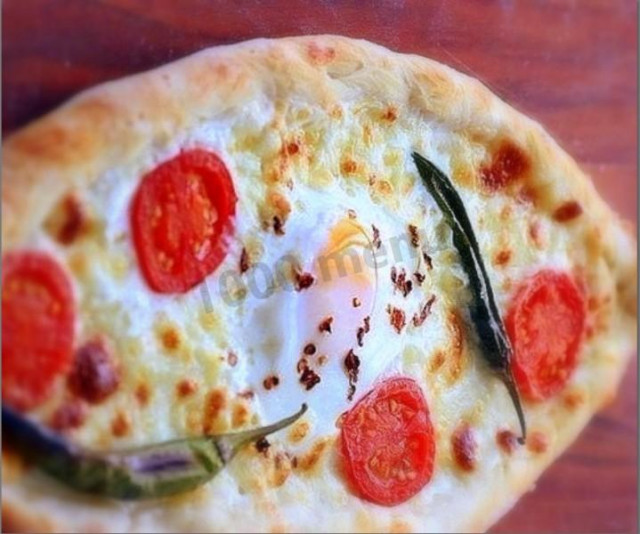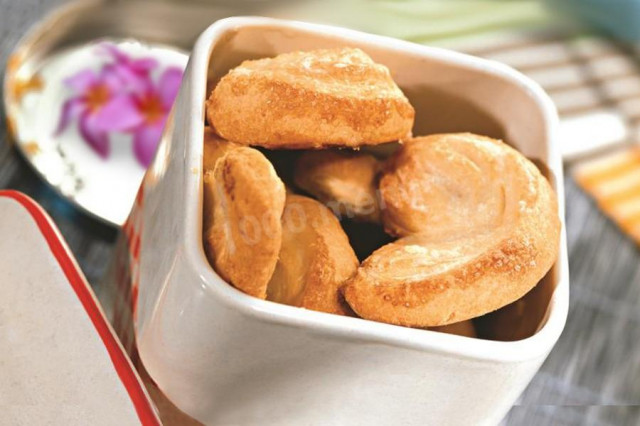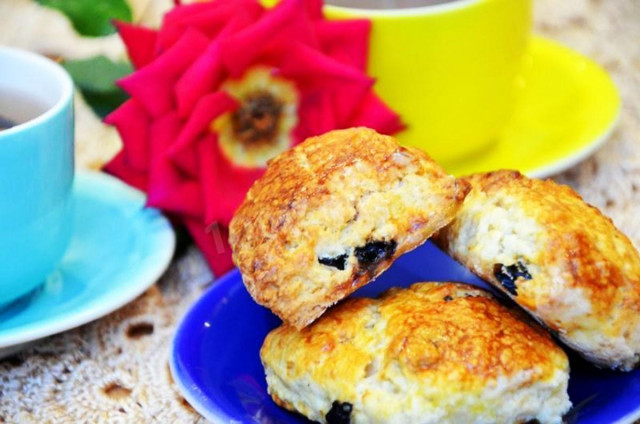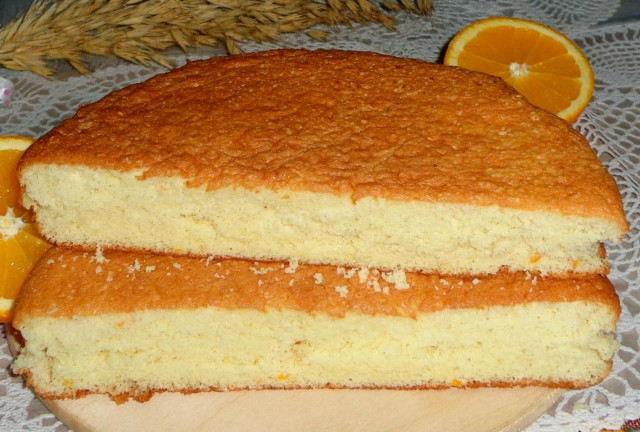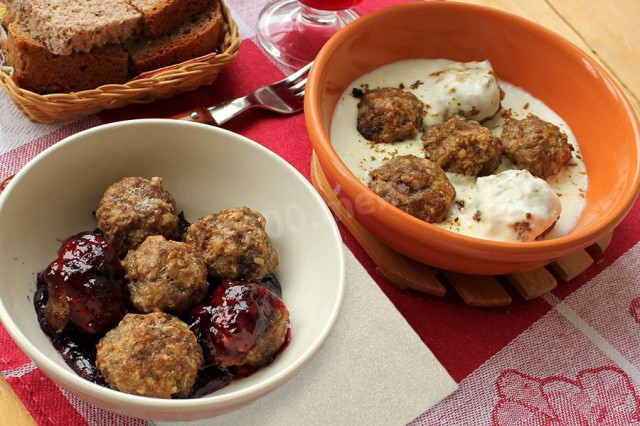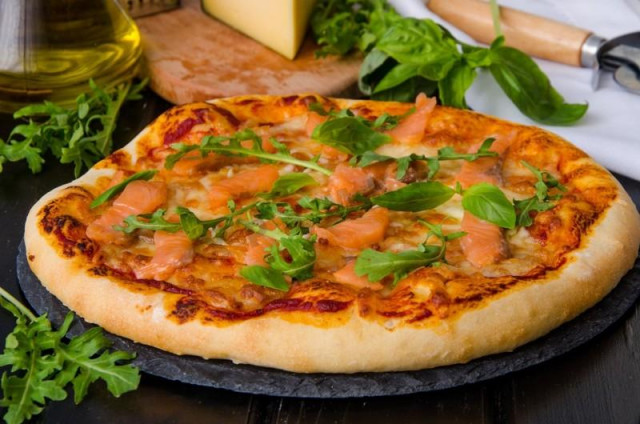Composition / ingredients
Step-by-step cooking
Step 1:
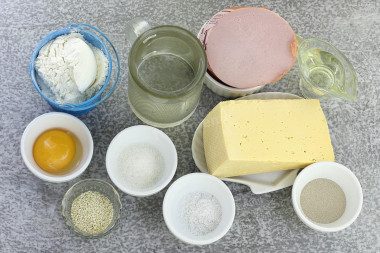
How to make rolls with sausage and cheese? Prepare all ingredients. Take refined vegetable oil. Buy the best boiled sausage. And to make the buns even more fragrant, take smoked. Buy cheese of those varieties that melt well when baking. You can replace sesame seeds with poppy seeds, flax seeds, or you can not use sprinkling. Take the flour of the highest or first grade, so that the buns turn out to be snow-white inside.
Step 2:
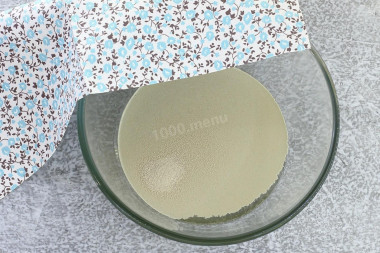
Heat the water to 35-38 degrees. At this temperature, yeast is activated faster. Add sugar. Mix it up. Yeast grows faster in a sweet environment. Add dry yeast. Mix it up. Cover with a cloth napkin and send to a warm place for 15-20 minutes. Dry yeast can be replaced with fresh yeast in an amount of 15 g. If the kitchen is quite warm, close the windows and leave the yeast container on the table.
Step 3:
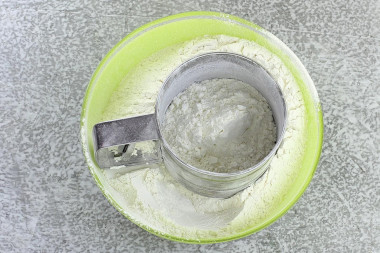
Meanwhile, prepare the flour. Be sure to sift it through a sieve. Thanks to this step, the dough will turn out to be more airy.
Step 4:
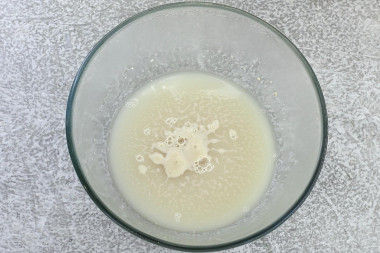
If the yeast is of high quality, foam should form on the surface. If it is not present, yeast of poor quality was used or the room was cool. In this case, the pastry may not rise and it will turn out to be clogged.
Step 5:
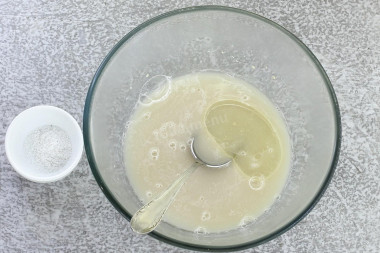
Pour vegetable oil into the sourdough and add salt. Mix it up.
Step 6:
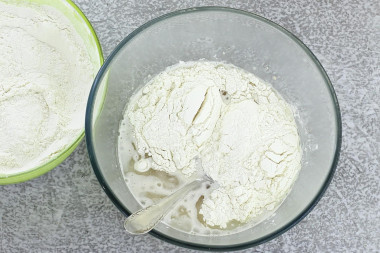
Add the prepared flour in small portions. After each addition of flour, mix well with a spoon so that all the ingredients are well moistened. You may take more or less flour than I do.
Step 7:
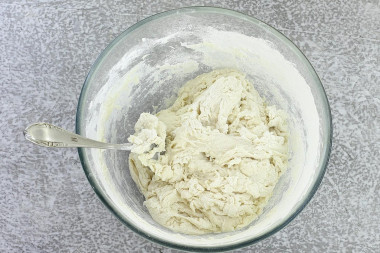
When the dough becomes quite dense and it's hard to knead with a spoon, it's time to continue kneading with your hands.
Step 8:
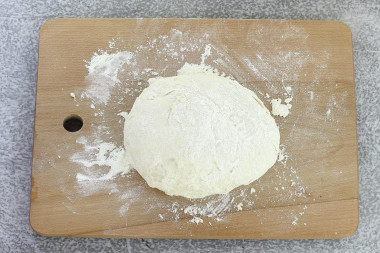
Dust the board with flour. Shift the dough and knead until you get a soft lump that does not stick to your hands. Gradually, if necessary, add flour. Since flour is different for everyone, its amount may vary within small limits and differ from what is stated in the recipe.
Step 9:
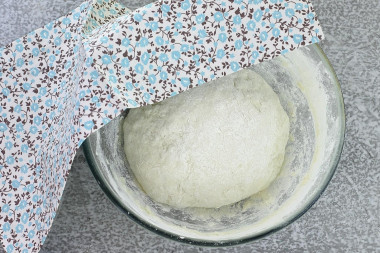
Put the dough back into a deep bowl. Cover with a cloth napkin and leave in a warm place for 90 minutes. The time indicated is approximate - the test may need either more or less minutes / hours to rise.
Step 10:
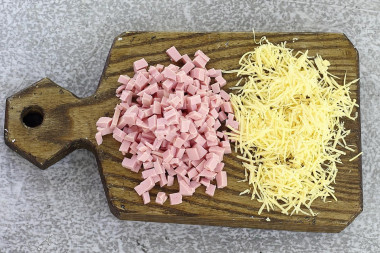
Meanwhile, prepare the filling for the buns. Cut the boiled sausage into small cubes. Grate hard cheese on a medium or coarse grater.
Step 11:
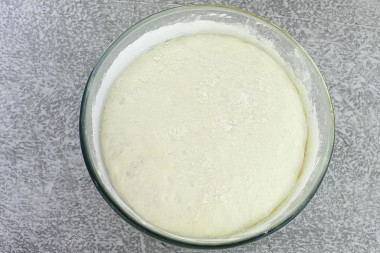
After the specified time in step 9, the dough increases 2-3 times. The proofing time of the dough depends on the room temperature and the quality of the yeast and can be more or less.
Step 12:
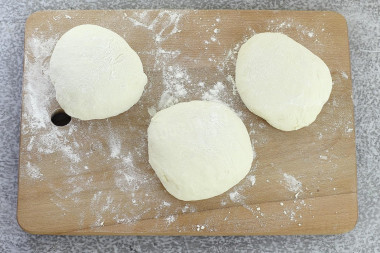
Move the rested dough to a dusty board and knead it well. Divide into 3 pieces. Form a ball from each one and work with each one in turn. While you are working with one piece, return the rest back to the bowl and cover with a napkin so that the dough does not chafe.
Step 13:
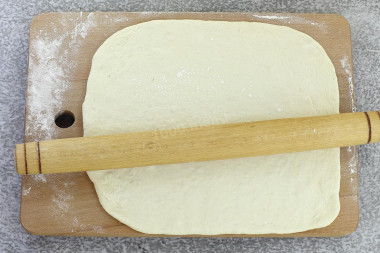
Roll out into a thin rectangular layer. If necessary, so that the dough does not stick to the board, dust the board with flour.
Step 14:
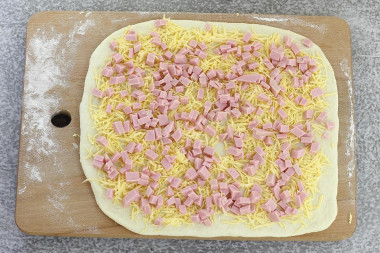
Divide the cheese and sausage figuratively into 3 parts. Part of the grated cheese and sliced sausage spread on a layer of dough.
Step 15:
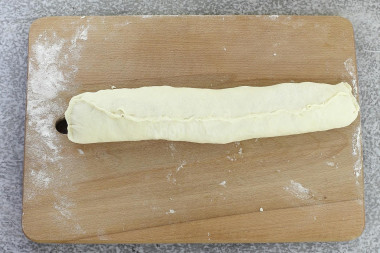
Twist into a tight roll and pinch the edges from the sides and along the entire length of the roll so that the filling remains inside.
Step 16:
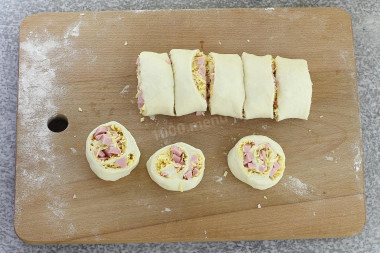
Cut into 8 serving pieces.
Step 17:
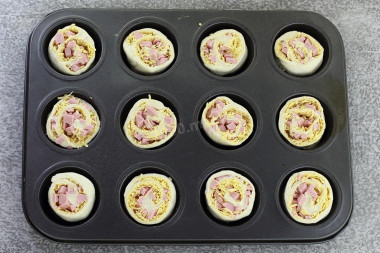
A metal baking tray, a heat-resistant mold is suitable for baking, or you can take cupcake molds, then the buns will turn out to be beautifully shaped. Cover the baking sheet and the mold with high-quality parchment so that the buns do not stick to the bottom. I didn't lubricate the iron molds with vegetable oil, and eventually, they stuck to the bottom. How I got out of this situation, I will tell you further. Cover the form with a cloth napkin and leave in a warm place for 25-35 minutes.
Step 18:
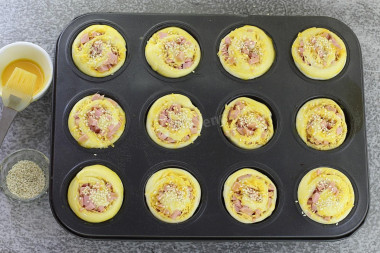
Shake the yolk. Lubricate the blanks. Sprinkle with sesame seeds. Preheat the oven to 190-200 degrees. Since everyone's equipment is different and has different power, focus on your oven. The baking time may differ from that specified in the recipe. Send it to bake for 20-25 minutes. To check if the buns are baked, take out the browned pastries and pierce them with a wooden skewer. If the dough does not stick, then the pastry is ready.
Step 19:
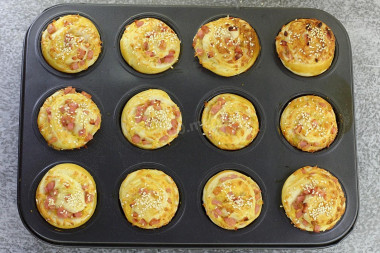
Rolls with sausage and cheese are ready. In this case, I couldn't get them out of the mold right away. In order to remove them from the molds, I covered them with a cloth napkin, added a plastic bag on top and covered them with a warm towel. Left for 15-20 minutes. After this procedure, she lightly dug with a spatula and removed it from the mold.
Step 20:
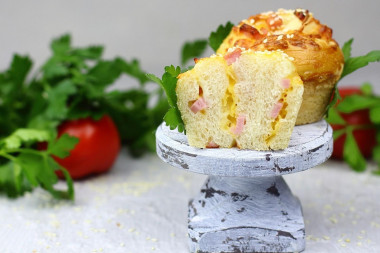
Immediately after baking, the buns are very, very soft, they melt right in your mouth. After complete cooling, they are well cut with a knife. Store them in a tightly closed container for no more than 1-2 days, then they will become more dense and will not be as tasty. Cold buns can be warmed up a little in the microwave before serving, this will give them airiness. Bon appetit!
To make any baked dish successful, use useful information about the features of ovens !
Rolls with sausage and cheese can be served with the first and second courses instead of bread. Delicious with milk, tomato juice and just like that.
Since buns, thanks to the shape for muffins, turn out smooth and beautiful, they can be used as a snack on a festive table. They look very good at receptions!
Be prepared for the fact that you may need more or less flour than indicated in the recipe. Focus not on the amount of flour, but on the desired consistency of the dough. To avoid mistakes, read about flour and its properties!
Caloric content of the products possible in the composition of the dish
- Dutch cheese - 352 kcal/100g
- Swiss cheese - 335 kcal/100g
- Russian cheese - 366 kcal/100g
- Kostroma cheese - 345 kcal/100g
- Yaroslavsky cheese - 361 kcal/100g
- Altai cheese 50% fat content - 356 kcal/100g
- Soviet cheese - 400 kcal/100g
- Cheese "steppe" - 362 kcal/100g
- Uglich cheese - 347 kcal/100g
- Poshekhonsky cheese - 350 kcal/100g
- Lambert cheese - 377 kcal/100g
- Appnzeller cheese with 50% fat content - 400 kcal/100g
- Chester cheese with 50% fat content - 363 kcal/100g
- Edamer cheese with 40% fat content - 340 kcal/100g
- Cheese with mushrooms of 50% fat content - 395 kcal/100g
- Emmental cheese with 45% fat content - 420 kcal/100g
- Gouda cheese with 45% fat content - 356 kcal/100g
- Aiadeus cheese - 364 kcal/100g
- Dom blanc cheese (semi-hard) - 360 kcal/100g
- Lo spalmino cheese - 61 kcal/100g
- Cheese "etorki" (sheep, hard) - 401 kcal/100g
- White cheese - 100 kcal/100g
- Fat yellow cheese - 260 kcal/100g
- Altai cheese - 355 kcal/100g
- Kaunas cheese - 355 kcal/100g
- Latvian cheese - 316 kcal/100g
- Limburger cheese - 327 kcal/100g
- Lithuanian cheese - 250 kcal/100g
- Lake cheese - 350 kcal/100g
- Gruyere cheese - 396 kcal/100g
- Granulated sugar - 398 kcal/100g
- Sugar - 398 kcal/100g
- Vegetable oil - 873 kcal/100g
- Dried whole sesame seeds - 563 kcal/100g
- Shelled sesame seed - 582 kcal/100g
- Salt - 0 kcal/100g
- Sausage "amateur" - 291 kcal/100g
- Sausage "Ukrainian" - 404 kcal/100g
- Diabetic sausage - 254 kcal/100g
- Sausage "doctor" - 197 kcal/100g
- Diet sausage - 170 kcal/100g
- Dairy sausage - 252 kcal/100g
- Water - 0 kcal/100g
- Wheat flour - 325 kcal/100g
- Egg yolks - 352 kcal/100g
- Dry yeast - 410 kcal/100g

